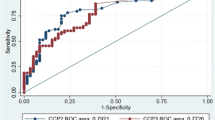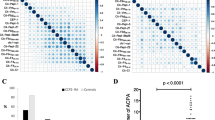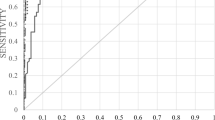Abstract
To compare the diagnostic powers of rheumatoid factor (RF) and anti-cyclic citrullinated peptide (CCP) in a population selected for its high statistical relevance, over a 6-month period, an informed consent to test for anti-CCP was obtained from 1,025 consecutive patients for whom RF was ordered at a University laboratory. Within 1 year, a diagnosis was obtained without informing the physician about the anti-CCP result. Extensive statistical analyses were performed. A total of 768 patients satisfied the inclusion criteria, and 132 were classified as having RA, yielding a pre-test probability of RA of 17%. The sensitivities for anti-CCP and RF were 62 and 64% (P = 0.83), and the specificities were 97 and 90% (P < 0.001), respectively. The positive predictive value (PPV) was 79% for anti-CCP and 56% for RF (P < 0.001), whereas the negative predictive value was 92% for both. The likelihood ratio (LR) was 17.9 for anti-CCP and 6.2 for RF (P < 0.005). Forty RA patients were diagnosed with RA of less than 2 years length, and the same significant statistic differences between anti-CCP and RF were observed. Placing the results of both tests together, or using different cutoff points, increased the diagnostic utility of the tests. The anti-CCP test has statistically shown significant higher specificity, PPV, and LR for RA than the RF test in a clinically diverse population. If new criteria are to be devised to help diagnose early RA, anti-CCP should be included because it has a greater diagnostic impact than RF.

Similar content being viewed by others
References
Van der Heijde D (1995) Joint erosions and patients with early rheumatoid arthritis. Br J Rheumatol 34:74–78
O’Dell JR (2002) Treating rheumatoid arthritis early: a window of opportunity? Arthritis Rheum 46:283–285
Arnett FC, Edworthy SM, Bloch DA et al (1988) The American Rheumatism Association 1987 revised criteria for the classification of rheumatoid arthritis. Arthritis Rheum 31:315–324
Ostergaard M, Ejbjerg B, Szkudlarek M (2005) Imaging in early rheumatoid arthritis: roles of magnetic resonance imaging, ultrasonography, conventional radiography and computed tomography. Best Pract Res Clin Rheumatol 19:91–116
Schumacher HR, Pessler F, Chen LX (2003) Diagnosing early rheumatoid arthritis (RA). What are the problems and opportunities? Clin Exp Rheumatol 21(5 Suppl 31):S15–S19
Goldbach-Mansky R, Lee J, McCoy A et al (2000) Rheumatoid arthritis associated autoantibodies in patients with synovitis of recent onset. Arthritis Res 2(3):236–243
Schellekens GA, de Jong BA, van den Hoogen FH et al (1998) Citrulline is an essential constituent of antigenic determinants recognized by rheumatoid arthritis-specific autoantibodies. J Clin Invest 101(1):273–281
Nienhuis RL, Mandema E (1964) A new serum factor in patients with rheumatoid arthritis; the antiperinuclear factor. Ann Rheum Dis 23:302–305
Young BJ, Mallya RK, Leslie RD et al (1979) Anti-keratin antibodies in rheumatoid arthritis. Br Med J 2(6182):97–99
Silveira IG, Keiserman MW, vonMühlen CA (2000) Clinical and laboratorial study of antiperinuclear factor in rheumatoid arthritis. Rev Bras Reumatol 40:159–167
Sebbag M, Simon M, Vincent C et al (1995) The antiperinuclear factor and the so-called antikeratin antibodies are the same rheumatoid arthritis-specific autoantibodies. J Clin Invest 95(6):2672–2679
Simon M, Girbal E, Sebbag M et al (1993) The cytokeratin filament-aggregating protein filaggrin is the target of the so-called “antikeratin antibodies,” autoantibodies specific for rheumatoid arthritis. J Clin Invest 92(3):1387–1393
Girbal-Neuhauser E, Durieux JJ, Arnaud M et al (1999) The epitopes targeted by the rheumatoid arthritis-associated antifilaggrin autoantibodies are posttranslationally generated on various sites of (pro)filaggrin by deimination of arginine residues. J Immunol 162(1):585–594
Union A, Meheus L, Humbel RL et al (2002) Identification of citrullinated rheumatoid arthritis-specific epitopes in natural filaggrin relevant for antifilaggrin autoantibody detection by line immunoassay. Arthritis Rheum 46(5):1185–1195
Serre G (2001) Autoantibodies to filaggrin/deiminated fibrin (AFA) are useful for the diagnosis and prognosis of rheumatoid arthritis, and are probably involved in the pathophysiology of the disease. Joint Bone Spine 68(2):103–105
Dubucquoi S, Solau-Gervais E, Lefranc D et al (2004) Evaluation of anti-citrullinated filaggrin antibodies as hallmarks for the diagnosis of rheumatic diseases. Ann Rheum Dis 63(4):415–419
Grootenboer-Mignot S, Nicaise-Roland P, Delaunay C et al (2004) Second generation anti-cyclic citrullinated peptide (anti-CCP2) antibodies can replace other anti-filaggrin antibodies and improve rheumatoid arthritis diagnosis. Scand J Rheumatol 33(4):218–220
De Rycke L, Peene I, Hoffman IE et al (2004) Rheumatoid factor and anticitrullinated protein antibodies in rheumatoid arthritis: diagnostic value, associations with radiological progression rate, and extra-articular manifestations. Ann Rheum Dis 63(12):1587–1593
Schellekens GA, Visser H, de Jong BA et al (2000) The diagnostic properties of rheumatoid arthritis antibodies recognizing a cyclic citrullinated peptide. Arthritis Rheum 43(1):155–163
Bas S, Perneger TV, Seitz M et al (2002) Diagnostic tests for rheumatoid arthritis: comparison of anti-cyclic citrullinated peptide antibodies, anti-keratin antibodies and IgM rheumatoid factors. Rheumatology (Oxford) 41(7):809–814
Bizzaro N, Mazzanti G, Tonutti E et al (2001) Diagnostic accuracy of the anti-citrulline antibody assay for rheumatoid arthritis. Clin Chem 47(6):1089–1093
Sauerland U, Becker H, Seidel M et al (2005) Clinical utility of the anti-CCP assay: experiences with 700 patients. Ann N Y Acad Sci 1050:314–318
Ronnelid J, Wick MC, Lampa J et al (2005) Longitudinal analysis of anti-citrullinated protein/peptide antibodies (anti-CP) during 5 year follow-up in early rheumatoid arthritis: anti-CP status is a stable phenotype that predicts worse disease activity and greater radiological progression. Ann Rheum Dis 64(12):1744–1749
Kroot EJ, de Jong BA, van Leeuwen MA et al (2000) The prognostic value of anti-cyclic citrullinated peptide antibody in patients with recent-onset rheumatoid arthritis. Arthritis Rheum 43(8):1831–1835
Solanki K, Spellerberg M, Chapman P et al (2004) Anti-cyclic citrullinated antibodies: complementary to IgM rheumatoid factor in the early diagnosis of rheumatoid arthritis. N Z Med J 117(1203):U1097
Moons KG, Biesheuvel CJ, Grobbee DE (2004) Test research versus diagnostic research. Clin Chem 50(3):473–476
Deeks JJ, Altman DG (2004) Diagnostic tests 4: likelihood ratios. BMJ 329(7458):168–169
Wolfe F (1998) A comparison of IgM rheumatoid factor by nephelometry and latex methods: clinical and laboratory significance. Arthritis Care Res 11(2):89–93
Knight RK, Pritchard MH (1982) Nephelometry compared with differential antibody titre in routine rheumatoid factor measurements. Ann Rheum Dis 41(4):426–430
Sackett DL, Haynes RB, Tugwell P (1985) Clinical epidemiology: a basic science for clinical medicine. Little, Brown & Co, Boston
Gallagher EJ (1998) Clinical utility of likelihood ratios. Ann Emerg Med 31(3):391–397
Radack KL, Rouan G, Hedges J (1986) The likelihood ratio. An improved measure for reporting and evaluating diagnostic test results. Arch Pathol Lab Med 110(8):689–693
Wolfe F, Cathey MA, Roberts FK (1991) The latex test revisited. Rheumatoid factor testing in 8,287 rheumatic disease patients. Arthritis Rheum 34(8):951–960
Visser H, Gelinck LB, Kampfraath AH et al (1996) Diagnostic and prognostic characteristics of the enzyme linked immunosorbent rheumatoid factor assays in rheumatoid arthritis. Ann Rheum Dis 55(3):157–161
Rantapaa-Dahlqvist S, de Jong BA, Berglin E et al (2003) Antibodies against cyclic citrullinated peptide and IgA rheumatoid factor predict the development of rheumatoid arthritis. Arthritis Rheum 48(10):2741–2749
Author information
Authors and Affiliations
Corresponding author
Appendix
Appendix
Appendix 1

Appendix 2
Rights and permissions
About this article
Cite this article
Silveira, I.G., Burlingame, R.W., von Mühlen, C.A. et al. Anti-CCP antibodies have more diagnostic impact than rheumatoid factor (RF) in a population tested for RF. Clin Rheumatol 26, 1883–1889 (2007). https://doi.org/10.1007/s10067-007-0601-6
Received:
Revised:
Accepted:
Published:
Issue Date:
DOI: https://doi.org/10.1007/s10067-007-0601-6




